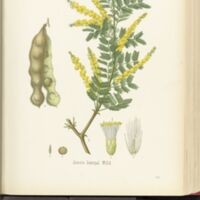Gum arabic (or acacia gum)
Dublin Core
Title
Subject
Description
Source
Fol. 74r. - “For making varnish”
Take one pound of linseed oil, and then you will put it in a earthen pot, mixed with a crust of bread and three onions, and put it on top of a charcoal fire, and you will cook it on a little fire, so that it boils for the space of five hours. You will take half an ounce of flour glue, & you will make it boil just as before and stir with a spoon. And then, after, you will put in two ounces of well-pestled sandarac & will do as above. And then after, you will take mastic & arabic, two ounces each, which will both be well ground, and you will put everything together, & will make it boil while stirring continuously, for the space of five hours. And then you will put rock alum, two ounces, & then you will make it boil. And if you add two ounces of arabic to it, if you see that they are not cooked enough, have it cook more on a low fire until it is cooked enough…
Fol. 74v - “For making yellow varnish”
Take some gum arabic & soak it with water, then take some well beaten saffron, & temper the said gum, and make it quite clear, then make your ground layer on that which you want to varnish, & let it dry, & when it is dry give another ground layer of the same, & let it dry as before until it is dry enough. Then take varnish from an apothecary, dash by blows, one quite far from the other. Then wash your hands quite well & with your palm spread your varnish.
Fol. 79v - “Making varnish”
Take some mastic, sandarac, gum arabic & spike lavender oil, as much of one as the other, & make them melt all together, & before coating it, lay a coat of glue quite clear, & let it dry.
Contributor
Alan Davidson, "Gum Arabic," in The Oxford Companion to Food, ed. Tom Jaine (Oxford University Press, 2014). https://www-oxfordreference-com.ezproxy.cul.columbia.edu/view/10.1093/acref/9780199677337.001.0001/acref-9780199677337-e-1112.
John S. Mills, “Gum,” Grove Art Online, 2003. https://www.oxfordartonline.com/groveart/view/10.1093/gao/9781884446054.001.0001/oao-9781884446054-e-7000035658.
Jonathan Stephenson, "Painting medium," Grove Art Online, 2003. https://www.oxfordartonline.com/groveart/view/10.1093/gao/9781884446054.001.0001/oao-9781884446054-e-7000064669.
L. Masschelein-Kleiner, "Gum arabic or acacia gum,” in Ancient Binding Media, Varnishes and Adhesives, trans. Janet Bridgland, Sue Walston, and A.E. Werner (Rome: ICCROM, 1985), 49.
Michael Clarke, "Gum Arabic," in The Concise Oxford Dictionary of Art Terms (2 ed.) (Oxford University Press, 2010). https://www-oxfordreference-com.ezproxy.cul.columbia.edu/view/10.1093/acref/9780199569922.001.0001/acref-9780199569922-e-839.
Image: Colored plate of Acacia Senegal from Köhler's Medizinal-Pflanzen vol.1 by Walter Müller, 1887.
Helena Seo, Columbia University
